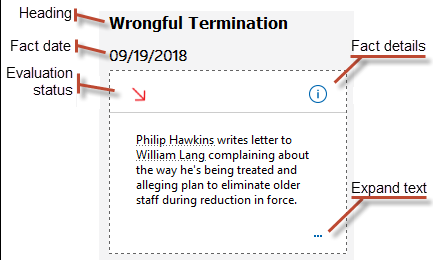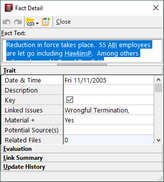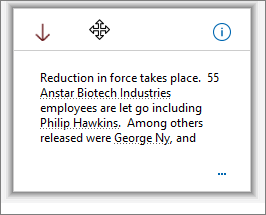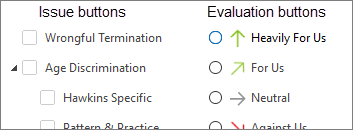The Fact Card view arranges facts chronologically, emphasizing fact text, timeline, issues, and evaluation. Working with fact cards can help you to speed up case analysis, and more easily recognize relationships between facts and find hidden narratives in your case.
You can use the Fact Card view to optimize your time you spend applying issues and evaluations to facts. The view provides an option to find facts you haven't yet assigned to an issue or evaluated.
To get the most out of the fact card view, your case should already have issues defined. For more information on issues, see: About issues. It will also help to understand how evaluation fields work in CaseMap. For more information, see: Evaluation fields.

Fact cards form a vertical chronology with options to assign and filter issues and evaluations.
Timeline organization
Facts are arranged vertically in ascending chronological order. Facts occurring on the same date are placed on the same row. Undated facts are placed in the bottom row. To change the sort order, go to the Home tab, click Sort & Filter, and select a sort option.
Filter facts by issue or evaluation
You can filter Fact Cards to show just the facts that are related to a particular issue or evaluation category. This offers the following benefits:
| • | Filtering by issue can help you to identify lines of reasoning and show how a situation has developed over time. |
| • | Filtering by evaluation gives you insight into the strengths and weaknesses of your case. |
| • | Filtering for and reviewing facts that have not yet been tied to issues can help you to uncover critical facts. |
| • | Filtering for and reviewing facts that have not yet been evaluated can help you to build confidence that your case strategy is viable. |
Assign issues and evaluations to facts
The Fact Card view allows you quickly assign issues and evaluations to facts via quick access to fact detail, button selection, and drag and drop.
Fact card elements

Fact cards consist of the following features:
| • | Heading. On the Issues tab, identifies the issue to which the fact has been linked. On the Evaluations tab, identifies the evaluation category the cards belong to. |
| • | Fact date. Identifies the date or date range when the fact occurred. |
| • | Evaluation status. Identifies the evaluation status that has been applied to the fact. |
| • | Fact details. Opens the fact details for editing or review. |
| • | Expand text. Opens a pop-out window containing all the fact text. Appears on Fact Cards that contain more text than can be displayed on the card. |
A major purpose of Fact Cards is to make it easier to assign issues and apply evaluations to facts. To facilitate this objective, Fact Cards allow three ways to make these assignments. These ways are described in the following table:

|
Click any card once to turn off drag and drop selection and show buttons instead. Click a card again to hide buttons and re-enable drag and drop.
|
|
| 1. | On the Home ribbon, click Fact Cards. |
| 2. | Click the Issues tab, if it is not already selected. |
| 3. | In the left pane, click the issue to see facts assigned ot it. |
|
| 1. | On the Home ribbon, click Fact Cards. |
| 2. | Click the Issues tab, if it is not already selected. |
| 3. | Click the card you want to change.
In the left pane, buttons appear next to the issues. If buttons do not appear immediately, click the card again. |
Select issues you want to assign to the fact.

|
Click any card once to turn off drag and drop selection and show buttons instead. Click a card again to hide buttons and re-enable drag and drop.
|
|
| 1. | On the Home ribbon, click Fact Cards. |
| 2. | Click the Issues tab, if it is not already selected. |
| 3. | Click the Uncategorized Facts list expander.

The expander shows the list of uncategorized facts. |
| 4. | To assign a fact to an issue, select it.
Check boxes appear in the issue list. |
| 5. | Select check boxes on issues you want the fact to be associated with.
Assignments are immediate. But the issue remains visible in the uncategorized list until the list is refreshed. |
| 6. | To refresh the list, click the white space between other cards in the list. |
|
| 1. | On the Home ribbon, click Fact Cards. |
| 2. | Click the Evaluation tab. |
| 3. | In the left pane, click an evaluation category to see facts assigned ot it. |
| o | To see facts that have not yet been evaluated, click the Unevaluated Facts expander. |

|
| 1. | On the Home ribbon, click Fact Cards. |
| 2. | Click the Evaluation tab. |
| 3. | In the left pane, click the Unevaluated Facts expander. |

| 4. | In the filtered list of facts, select the fact you want to evaluate.
Radio buttons appear next to the evaluation categories in the left pane. |
| 5. | Select the evaluation category you want to apply. |
The Evaluation field for the fact is changed to the value you selected.
| 6. | Click a different card. |
The card you evaluated is removed from the Unevaluated Facts list.
|
| 1. | On the Home ribbon, click Fact Cards. |
| 2. | On the Fact Card you want to change, click  the fact detail button. the fact detail button. |
The fact detail dialog box opens.
| 4. | Select an evaluation for the fact and then click Close. |
|
By default, Fact Cards are sorted in ascending chronological order, but you can change the sort order to descending.
| 1. | Click Sort & Filter on the Home ribbon. |
| 2. | Click the option to Sort Ascending or Sort Descending. |
|
You can run a Fact Chronology report populated with the facts that are listed in the Fact Card view.

|
Uncategorized facts are not included in the report.
|
| 1. | Open the Facts spreadsheet. |
| 2. | On the Home menu, click Fact Cards. |
| 3. | Select the issues you are want to include in the report. Or to create a report on evaluated facts, click the Evaluation tab, and then select an evaluation category. |
| 4. | On the Reports ribbon, click Print and then click Preview. |
| 5. | Inspect the print preview, then print, save, or send the report as needed. |
|
You can create facts in the Fact Cards view.
| 1. | Open the Facts spreadsheet. |
| 2. | On the Home menu, click Fact Cards. |
| 3. | On the Home ribbon, click New Fact. |
| 4. | Enter the fact details and then click Close. |
The new Fact Card can be found in the corresponding Issue and/or Evaluation status.

|
If you do not assign an issue to the fact, the new fact is placed in the Uncategorized Facts list.
|
|
You can permanently delete facts from the case while working in Fact Cards view.
| 1. | Select the Fact Card you want to delete. |
| 2. | Do either of the following: |
| o | Click Delete on the Home ribbon. |
| 3. | Click Yes to confirm deletion. |

|
Once the Fact Card has been deleted, the fact is permanently removed from the case.
|
|





